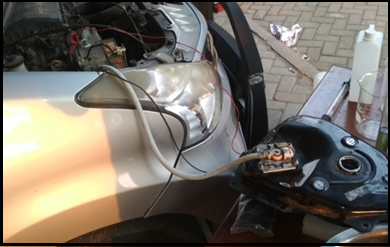Main Article Content
Abstract
Cassava biogasoline was tested on electronic fuel injection vehicles in urban traffic conditions with varying engine load. Biogasoline tested includes B0, B10, B20, and B30. The engine speed was operated within 750 to 1800 rpm (low-speed range) to simulate urban traffic condition. The engine load was varied through the operation of air conditioner (AC). Fuel consumption was measured in real terms (ml/s) and CO emissions were measured with the Hesbon HG 520 Engine Gas Analyzer (EGA) in the percentage of total exhaust gas. The results showed that B10 has the lowest fuel consumption of 0.24 ml/s in conditions without AC and 0.41 ml/s with AC. Meanwhile, CO emissions tend to be constant with change in the proportion of cassava biogasoline and increased with additional AC load.
Keywords
Article Details
References
- Badan Pusat Statistik, “Perkembangan Jumlah Kendaraan Bermotor Menurut Jenis, 1949-2017,” 2018. [Online]. Available: https://www.bps.go.id/linkTableDinamis/view/id/1133. [Accessed: 07-Nov-2019].
- Deendarlianto et al., “Scenarios analysis of energy mix for road transportation sector in Indonesia,” Renewable and Sustainable Energy Reviews, vol. 70, no. November, pp. 13–23, 2017.
- U.S Environmental Protection Agency, “Air Quality Index: a guide to air quality and your Health,” Washington, DC, 2014.
- B. A. Prasetyo, D. A. Izani, M. Setiyo, N. Widodo, Saifudin, and B. C. Purnomo, “Estimasi Pemborosan Bahan Bakar Akibat Kemacetan Menggunakan Analisis Citra Google Map (Studi Kasus pada Simpang Armada Town Square Mall Magelang),” Automotive Experiences, vol. 1, no. 2, pp. 36–42, 2018.
- A. Baswedan et al., “Problem Kemacetan Jakarta,” Update Indonesia, vol. 5, no. 5, pp. 1–25, 2010.
- C. Pothiraj, A. Arun, and M. Eyini, “Simultaneous saccharification and fermentation of cassava waste for Ethanol production,” Biofuel Research Journal, vol. 2, no. 1, pp. 196–202, 2015.
- B. A. Adelekan, “Investigation of ethanol productivity of cassava crop as a sustainable source of biofuel in tropical countries,” African Journal of Biotechnology, vol. 9, no. 35, pp. 5643–5650, 2010.
- K. Kuiper, L., Ekmekci, B., Hamelinck, C., Hettinga, W., Meyer, S., Koop, “Bio-ethanol from Cassava,” Project number: PBIONL062937, no. November, pp. 1–13, 2007.
- D. G. Martinez, A. Feiden, R. Bariccatti, and K. R. de F. Zara, “Ethanol production from waste of cassava processing,” Applied Sciences (Switzerland), vol. 8, no. 11, pp. 1–8, 2018.
- IEA, “Automotive Fuels for the Future- The Search for Alternatives,” 2000.
- R. M. Ceballos, Bioethanol and Natural Resources: Substrates, Chemistry and Engineered Systems, 1st Editio. Florida: CRC Press, Taylor and Francis Group, 2017.
- S. Prasad and M. S. Dhanya, “Air Quality and Biofuels,” in Environmental Impact of Biofuels, M. A. dos S. Bernardes, Ed. London: IntechOpen, 2011, pp. 227–250.
- B. Waluyo, I. N. G. Wardana, L. Yuliati, and M. N. Sasongko, “The role of molecule cluster on the azeotrope and boiling points of isooctane-ethanol blend,” Fuel, vol. 215, no. September 2017, pp. 178–186, 2018.
- M. Wahyu and H. Rahmad, “The Effect of 10% Bioetanol and Carbon Cleaner Mixtures with Engine Gurah Technique on The Level of CO Emission in Corolla Twincam AE92,” VANOS Journal Of Mechanical Engineering Education, vol. 3, no. 2, pp. 163–172, 2018.
- A. Triwiyatno, E. W. Sinuraya, J. D. Setiawan, and S. Munahar, “Smart controller design of air to fuel ratio (AFR) and brake control system on gasoline engine,” in 2nd International Conference on Information Technology, Computer, and Electrical Engineering, 2016, pp. 233–238.
- A. Hilier, Fundamentals of Motor Vehicle Technology, 6th Editio. Oxford: Oxford University Press, 2014.

